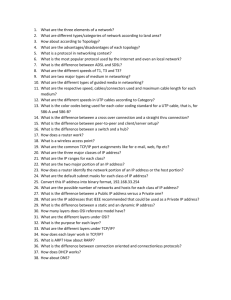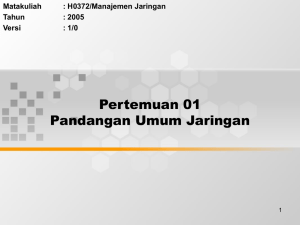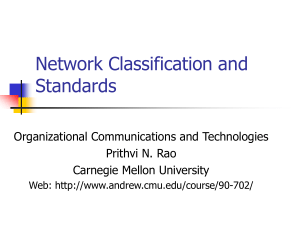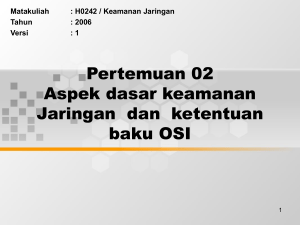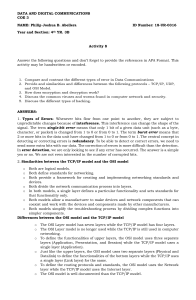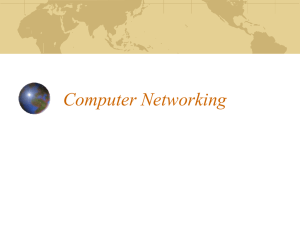Pertemuan 01 Teknologi Jaringan Matakuliah : H0242 / Keamanan Jaringan
advertisement
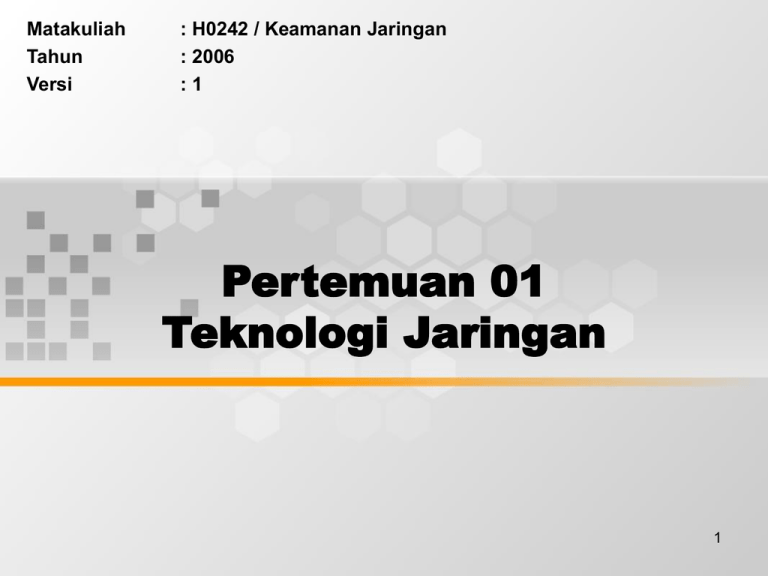
Matakuliah Tahun Versi : H0242 / Keamanan Jaringan : 2006 :1 Pertemuan 01 Teknologi Jaringan 1 Learning Outcomes Pada akhir pertemuan ini, diharapkan mahasiswa akan mampu : • Mahasiswa dapat menjelaskan komponen dan protokol jaringan TCP/IP 2 Outline Materi • OSI dan TCP/IP Model • IP, UDP dan TCP • Komponen Jaringan 3 Data Networks • Data networking solutions – Local-area networks – Wide-area networks 4 Networking Devices Equipment that connects directly to a network segment is referred to as a device. These devices are broken up into two classifications. The first classification is end-user devices. The second classification is network devices. 5 Network Protocols • Protocol suites are collections of protocols that enable network communication from one host through the network to another host. • A protocol is a formal description of a set of rules and conventions that govern a particular aspect of how devices on a network communicate. 6 WAN Technologies • • • • • • • Analog modems Integrated Services Digital Network (ISDN) Digital Subscriber Line (DSL) Frame Relay Asynchronous Transfer Mode (ATM) E carrier series: E1, E3 Synchronous Digital Hierarchy (SDH) 7 Intranets and Extranets • Intranets are designed to permit access by users who have access privileges to the internal LAN of the organization. • Extranets refer to applications and services that are Intranet based, but that use extended, secure access to external users or enterprises. 8 OSI Reference Model • The application (upper) layers – Layer 7: Application – Layer 6: Presentation – Layer 5: Session • The data-flow (lower) layers – Layer 4: Transport – Layer 3: Network – Layer 2: Data link – Layer 1: Physical 9 Layers with Functions 10 The Purpose of OSI Model • It breaks network communication into smaller, simpler parts that are easier to develop. • It facilitates standardization of network components to allow multiple-vendor development and support. • It allows different types of network hardware and software to communicate with each other. • It prevents changes in one layer from affecting the other layers so that they can develop more quickly. • It breaks network communication into smaller parts to make learning it easier to understand. 11 Peer-to-Peer Communication • For data to travel from the source to the destination, each layer of the OSI model at the source must communicate with its peer layer at the destination. • During this process, the protocols of each layer exchange information, called protocol data units (PDUs), between peer layers. • Each layer of communication on the source computer communicates with a layer-specific PDU, and with its peer layer on the destination computer. 12 The TCP/IP Reference Model 13 TCP/IP Protocol 14 Applications • • • • • FTP HTTP SMTP DNS TFTP – File Transfer Protocol – Hypertext Transfer Protocol – Simple Mail Transfer Protocol – Domain Name System – Trivial File Transfer Protocol 15 OSI Model and TCP/IP Model 16 Data at Each Layer 17
